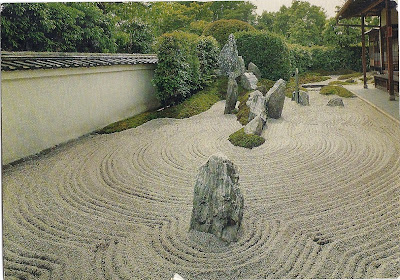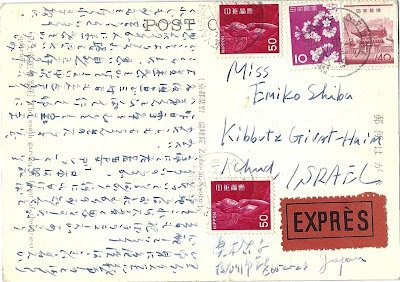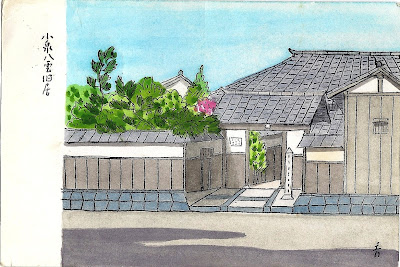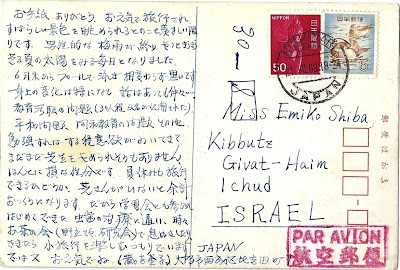Anyway, both postcards are lovely; still very 'representative', as postcards are wont to be, but in a much gentler way than the previous one, I think - probably because they were sent by locals, rather than tourists. They were very obviously written by two different people, as the writing is vastly different. But I can't read them.
אם כבר ביפן עסקינן, יש לי עוד שתי גלויות יפניות - ומכיוון שהן נשלחו לאותה נמענת, חשבתי לצרף את שתיהן לרשומה אחת. שתי הגלויות נשלחו למישהי בשם אֶמִיקוֹ שִׁיבָּה, בקיבוץ גבעת חיים איחוד, בשנת 1969. יכול להיות שהיא התנדבה שם, במסגרת גל המתנדבים שהגיעו לארץ אחרי מלחמת ששת הימים, למרות שאני קצת תוהה כמה מתנדבים יפנים כבר היו (אבל אולי זה רק עניין של סטריאוטיפים?). ויש גם את כת המָקוּיָה, שיש לה כמה מרכזים בישראל, ואולי לכן היא באה. אני לא יודעת.
בכל אופן, שתי הגלויות מקסימות; הן עדיין מאוד 'ייצוגיות', כי ככה זה עם גלויות בדרך כלל, אבל בעיניי זה באופן הרבה יותר עדין מאשר הגלויה הקודמת - מן הסתם כי שלחו אותן תושבי המקום, ולא תיירים. מאוד ברור שיש כאן שני כותבים שונים, כי הכתב שונה לחלוטין. אבל אני לא יכולה לקרוא אותן.
בכל אופן, שתי הגלויות מקסימות; הן עדיין מאוד 'ייצוגיות', כי ככה זה עם גלויות בדרך כלל, אבל בעיניי זה באופן הרבה יותר עדין מאשר הגלויה הקודמת - מן הסתם כי שלחו אותן תושבי המקום, ולא תיירים. מאוד ברור שיש כאן שני כותבים שונים, כי הכתב שונה לחלוטין. אבל אני לא יכולה לקרוא אותן.
Postcard 1, front:
גלויה 1, צד קדמי:
Back:
צד אחורי:
My guess is that this first postcard was written by an older person than the second - I think mostly because of the fact that the writing is from top to bottom, which is more traditional, while in the second one it's from left to right, which is a modern adaptation (actually, I think in the past you could write either way, but I know that modern Japanese writing is almost all left-to-right). The first postcard's writing is also much more 'freehand' and streaming in style, while the second one is more neat and round, but that might just be a matter of personal styles.
אני מנחשת שהכותבת של הגלויה הראשונה (אני לא יודעת למה יש לי הרגשה שמדובר בנשים, אולי רק בגלל שזו נמענת ולא נמען... בכל אופן, באנגלית אפשר להתחמק, אבל בעברית קשה יותר) היתה מבוגרת יותר מהכותבת של השנייה - אני חושבת שזה בעיקר מפני שהגלויה הראשונה כתובה מלמעלה למטה, שזו צורה מסורתית יותר, והשנייה כתובה משמאל לימין, שזה יותר מודרני (בעצם נדמה לי שבעבר אפשר היה לכתוב בשתי הצורות, אבל אני יודעת שכתיבה יפנית מודרנית היא כמעט תמיד משמאל לימין). הכתב בגלויה הראשונה גם 'חופשי' וזורם יותר בסגנון שלו, ולעומתו הכתב בגלויה השנייה נראה יותר מסודר ועגול, אבל יכול להיות שזה פשוט עניין של סגנון אישי.
Postcard 2, front:
גלויה 2, צד קדמי:
Back:
צד אחורי:
Actually, when I said I can't read this, it wasn't 100% accurate - I can read one word in the second postcard (no, not 'JAPAN', ya smartasses, one word in the Japanese). Through the little Japanese I learnt many many years ago I managed to make out the second word, arigatou, 'thank you'. I can recognise a few more Hiragana symbols here and there, but I can't connect any of them into words I know. And in the first postcard I really can't understand anything. So, this doesn't really count.
האמת היא שכשאמרתי שאני לא יכולה לקרוא אותן, זה לא היה מדויק ב-100% - אני יכולה לקרוא מלה אחת בגלויה השנייה (לא JAPAN, יא חוכמולוגים, מלה אחת ביפנית). בעזרת מעט היפנית שאני זוכרת ממה שלמדתי לפני שנים אני יכולה לזהות שהמלה השנייה היא אָרִיגַטוֹ, 'תודה'. אני מסוגלת לזהות עוד כמה סימני היראגאנה פה ושם, אבל הם לא מתחברים לי לשום דבר מוכר. ובגלויה הראשונה אני ממש לא יכולה להבין כלום. אז זה לא ממש נחשב.
But 'thank you' is still something. Probably thanks for a letter or a package. Or maybe for something else.
Anyone here can read Japanese? Skoshi dake Nihon-go ga dekimas kedo: I can only speak a little Japanese.
ובכל זאת, גם 'תודה' זה משהו. תודה על גלויה או חבילה, מן הסתם. או אולי על משהו אחר.
מישהו כאן קורא יפנית? סְקוֹשִׁי דַקֶה נִיהוֹן-גוֹ גָה דֶקִימַס קֶדוֹ: אני יודעת לדבר רק קצת יפנית.
מישהו כאן קורא יפנית? סְקוֹשִׁי דַקֶה נִיהוֹן-גוֹ גָה דֶקִימַס קֶדוֹ: אני יודעת לדבר רק קצת יפנית.



